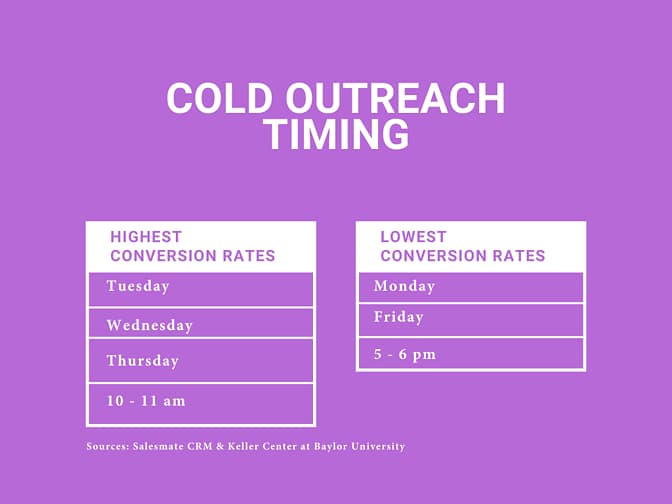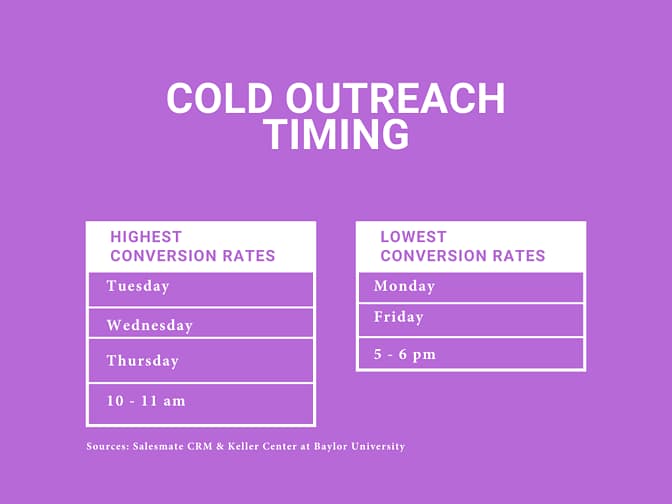6 Outbound Calling Best Practices to Improve Answer Rates

Start Making More Calls Today
Not sure which solution would be the best fit for your needs? We can work with you to find a solution that’s right for your business.
get a free quoteThe act of making a phone call isn’t enough to reach someone in 2021 – there needs to be a strong strategy behind it. People have become numb to the influx of spam and telemarketer calls they’ve received in recent years, causing connection & answer rates to plummet. It’s more likely than ever before that the person you’re trying to reach will let your call go to voicemail without a second thought.
By following these outbound calling best practices and developing a strong strategy behind them, your connection & answer rates don’t have to suffer.
Outbound Calling Best Practices
#1: Make Outbound Calls at The Right Time
The first step to improving your answer rates is knowing when to call. Even with limited information about the contacts you’re trying to reach, this can be helpful.
In a study conducted by Salesmate CRM, the best days and times to make a sales call were revealed. Based on the number of call attempts and successful conversations that took place, the following conclusions were made:
🔷 When to call: Tuesday, Wednesday & Thursday in the evening between 4 & 5 pm, or in the morning between 10 & 11 am.
🔶 When not to call: Anytime between 2 & 3 pm or 5 & 6 pm on a Friday
A study conducted by the Keller Center at Baylor University revealed similar results on the best times to conduct cold outreach, but for the real estate industry. The data gathered from the study confirmed that 10 – 11 am was the optimal time to engage in outbound calling, and also showed positive results for calls made between 11 am & 2 pm. Calls made during these times yielded a forty-two percent higher conversion rate than those made between 8 & 10 am, and 300% higher than calls made after 5 pm.
Other than the time of day/week, you can also adjust your outbound call volume based on seasonality. If you’re looking to increase sales, during which time of the year will your target customers be looking for the type of product/service you offer? If you’re looking to collect on a debt, when will your contact be most likely to pay?
Determining the answers to these questions and implementing this best practice into your outbound calling strategy can help you improve your answer rates.

#2: Focus Outbound Calling Efforts on New Contacts
New contacts often need the most assistance when making a payment or purchasing your product for the first time. Optimize your time and answer rate by focusing your outbound calling efforts on these individuals, who are most likely to want to answer your call.
Current customers that have already purchased your product/service in the past, or consumers that have dealt with your company in the past may be less likely to have extensive questions. These contacts are more likely to call you if they have a question, rather than answer a call from your business when they feel it’s not necessary.
When your outbound calling strategy focuses on new contacts as opposed to your well-seasoned customers, it’s likely that you’ll begin to see improvements in your answer rates.
What The Research Says: According to McKinsey Digital, 76% of B2B buyers preferred to speak to a salesperson when purchasing a completely new product or service, as opposed to 15% when purchasing the same product or service as before.
#3: Don't Prioritize Outbound Over Inbound
Just because you focus your outbound calling efforts on new contacts, doesn’t mean you should neglect incoming calls from your current customers. If someone calls your business, you need to have people ready to answer and be there for them!
Never allow your outbound calling strategy to overshadow the customer service you provide for consumers and customers – both are equally important. If you can’t retain your current customers because of poor customer service, retention will become a problem and your costs for attracting new customers will increase.
The key is to balance how well your company handles inbound calls while executing a successful outbound calling strategy. Don’t let one negate the success of the other!
#4: Incorporate Local Presence Dialing Into Your Strategy
Did you know that people are four times more likely to answer a local number? We did. That’s why Arbeit Software offers dynamic caller ID with each of our cloud-based contact software solutions.
So, what exactly is local presence dialing? Using dynamic caller ID, you’re able to make calls from the area you are in, but show as a number from the area of the contact that you call out to. From your contact’s perspective, it looks like someone in their area is calling them, even though you may not be physically near them.
Gallup, a firm that makes a large number of daily outbound calls for poll purposes, saw a thirteen to twenty-four percent increase in call center productivity when they began incorporating local presence dialing into their strategy. They even stated that the gains in productivity “made the additional costs associated with changing these phone numbers worthwhile.”
It’s also important to note that dynamic caller ID & local presence dialing are NOT considered illegal number spoofing. They differ from one another in terms of legality & efficacy.
Number spoofing is not only illegal, but also ineffective. It involves tricking carriers by using phone numbers that are owned by another entity. Because of this, consumers can’t call back spoofed numbers meaning that your calls can’t be returned.
With dynamic caller ID, you are the legal owner of a given set of local phone numbers. So if a contact misses your call, they are able to return that call using the local number that appeared on their caller ID.

What Our Research Says:
We wholeheartedly believe in the benefits of using dynamic caller ID, so we decided to conduct our own survey on it. The results demonstrated the benefits of local presence dialing using dynamic caller ID – 75% of respondents stated that they’d be extremely unlikely to answer a call from an unfamiliar area code or 800 number. Although incorporating dynamic caller ID into your outbound calling strategy doesn’t necessarily mean you’ll get those 75% of contacts on the phone, it does mean that the likelihood of these consumers answering is higher.
By enabling dynamic caller ID, you will accomplish three things:
- Make more connections – based on the data from our survey and what we continually hear from our clients, the likelihood of your answer rate increasing will skyrocket when you enable dynamic caller ID.
- Turn unanswered calls into returned calls – inbound calls are often the highest converting and therefore can improve employee engagement.
- Spend more time focusing on the content of each call – the bigger picture with all of this is to spend more time having conversations with consumers. Getting your calls answered is a huge piece of this and once you can achieve this, you will be able to focus less on logistics and more on the conversations you have with consumers.
#5: Avoid The Incriminating Three Second Pause
Did you know that 75% of consumers will hang up when they hear a three second pause on your end?
Having an awesome connection & answer rate is great and all, but isn’t keeping the contact on the line even better? We’d say so. The three second pause can cause your contact to hang up for two reasons. One is pretty obvious – it sounds like there’s nobody on the other end of the line. The second reason, you may find surprising. For a consumer, that three-second pause can indicate an Automatic Telephone Dialing System (ATDS), which could cost you a potential lawsuit.
You don’t want to let your outbound calling efforts harm your business’ productivity and create additional costs. So how can you remove the three second pause? With our TCPA Compliant Dialer, Arbeit Software has removed that pause to help you stay stress-free and keep contacts on the line. There really isn’t any other dialer software that can do that for you.
#6: Numeracle Entity Vetting & Phone Number Registration
When carriers and call blocking and labeling apps aren’t sure who you are and why you’re calling, your calls can be improperly delivered with Scam or Spam labels, incorrect caller ID names, or even be blocked at the network level.
Verified Identity™ certification + phone number registration through Numeracle let carriers and apps know who you are and why you’re calling. The benefits of enabling these services are:
- Prevention of erroneous call blocking
- Ongoing visibility into spam-rated numbers
- Improved consistency of your caller ID name (where able to be displayed)
- Preparation for call authentication via STIR/SHAKE
With the power of Numeracle your phone calls are more likely to reach consumers’ devices. When dynamic caller ID is enabled with phone number reputation monitoring, you’re also able to adjust your strategy & determine the best time to switch out specific numbers. This in turn will facilitate the successful delivery of more phone calls, less scam and spam likely calls for the consumer, and optimal connection rates for your business.
Clients who use our TCPA compliant dialer in combination with dynamic caller ID and Numeracle have seen a 3% increase in answer rates.
Three percent might not seem like a lot. But consider how significant this amount can be in terms of revenue. How much money does a 3% increase in conversations mean? For some agencies, this can be thousands.
Focusing on the bigger picture – having more pleasant conversations – is something we at Arbeit are on a mission to see our clients achieve.
Arbeit Software can help you begin to build a strong outbound calling strategy in just about any industry including sales, debt collection and real estate. Let us provide you with the tools for a solid foundation, and you’ll be able to take the rest from there.
About The Author
Alex Villafranca
Alex is the CEO, co-founder and Head of Revenue at Arbeit, a better outbound communication software that makes businesses more profitable.